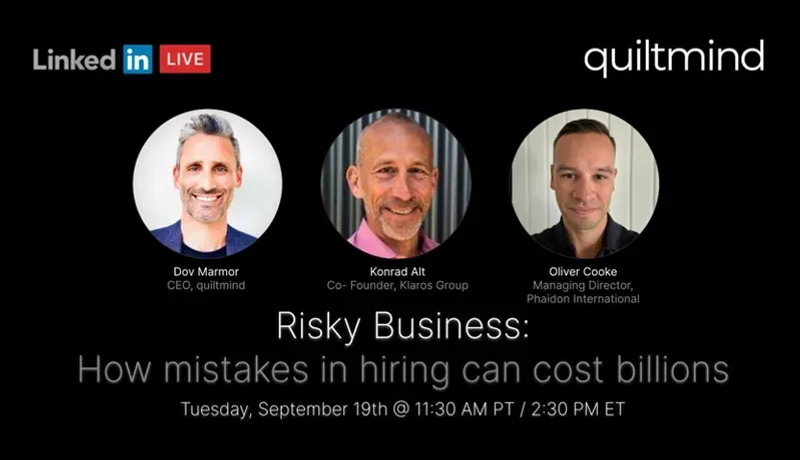5 key takeaways from Dallas Managing Director Oliver Cooke on getting hiring wrong in risk management.
What’s harder than retaining talent in financial services? Finding it in the first place. There is a growing need for a diverse, skilled workforce, but identifying and acquiring those workers can be a difficult task. On September 19, our very own Oliver Cooke sat down with Dov Marmor, CEO at quiltmind and Konrad Alt, Founder of Klaros Group, to discuss this very topic on LinkedIn Live. Keep reading for the five most crucial insights every hiring manager in risk management in the financial services industry must know.
The best hiring managers are always recruiting, even when they’re not recruiting.
Being a serial networker isn’t just good for clout on LinkedIn—it can seriously pay off when your organization has to move quickly to hire. Having a bench of prospective hires will allow you and your firm to be more agile when you need to fill a senior role fast, which is oftentimes when it matters most. Cooke notes that Silicon Valley Bank would have greatly benefited from this strategy, as they were notably without a Chief Risk Officer for nearly six months when they collapsed.
“It doesn’t matter if it’s risk or any other role, a truism is that people will leave,” Marmor adds. “So you always need to have a plan and just assume the worst and be ready for that to happen.”
Sourcing risk talent is only going to get more competitive with time
It’s perhaps easier to answer the question of which areas of the banking industry aren’t interested in bolstering their risk operations than those that are. In the last 6-12 months, Cooke has noticed a pickup in risk hiring, particularly post-SVB.
“Three areas we’ve seen pickups in are liquidity risk, asset liability management, and treasury. A lot of organizations are looking very closely at how they manage their capital, their assets and consequently hiring talent to support that,” he says.
Conversely, Cooke also points out that here at Selby Jennings we have seen a lot of growth in operational risk and, within that, technology risk. There has been growth in hedge fund credit risk and counterparty credit risk off the back of the meme stock craze last year, too.
One thing all these areas have in common is that they are taking a more quantitative and AI-driven approach to risk management—and while AI is expected to improve risk management, it also introduces new challenges related to data privacy and information security.
Quants with communication skills will prove to be the most valuable talent
Quantitative expertise is expected when it comes to the talent pool within risk management, but what differentiates an excellent candidate from a good candidate is the ability to communicate. Hiring quants that can communicate complex concepts in a digestible and actionable manner is crucial to bridging the gap between quants and executive leadership at your organization, thereby mitigating risk. In some cases, quants and risk managers can eventually move into executive leadership roles, as evident with CS Venkatakrishnan, who became CEO of Barclays after 25 years of leading risk and quant risk groups across Wall Street, Cooke points out.
Hiring overseas talent requires planning into costs and hiring cycles
Nearly 50-70% of risk talent originally comes from overseas, most notably within STEM-focused education. The process of securing H1B visas for foreign talent can be time-consuming and costly, posing challenges for organizations with immediate needs. Strengthening domestic STEM talent won’t happen overnight, so employers must plan for the lead time and costs associated with hiring foreign talent. It ends up being well worth the investment of course, and gives you access to a wider talent pool instead of just looking domestically, but many firms don’t realize that until it’s time to hire, and it ends up delaying critical project timelines. Approval for an H1B visa can take anywhere from 6-12 weeks after offer acceptance, and is likely to cost between $5,000-$10,000.
Staffing your firm with risk professionals yields long-term benefits
In his 12+ years of experience in the market, Cooke has observed that companies often struggle with viewing risk management as a cost and not a revenue generator, especially in a macroenvironment where most organizations are looking at how they manage their costs very closely. On top of that, the supply-demand imbalance drives up the compensation, making it increasingly difficult for cash-strapped companies to justify the spend. When risk isn’t managed properly, however, companies can face millions—sometimes even billions—in fines and sanctions or collapse entirely, like in the case of SVB. “It can cost an organization up to billions of dollars if they don’t have the right talent and processes in place,” says Cooke. “It’s 100% necessary to make the business run effectively and make smart decisions.”
Are you looking to hire world-class risk management talent for your organization? Submit a vacancy or request a call back today, and one of our expert consultants will get back to you and schedule a confidential conversation.
